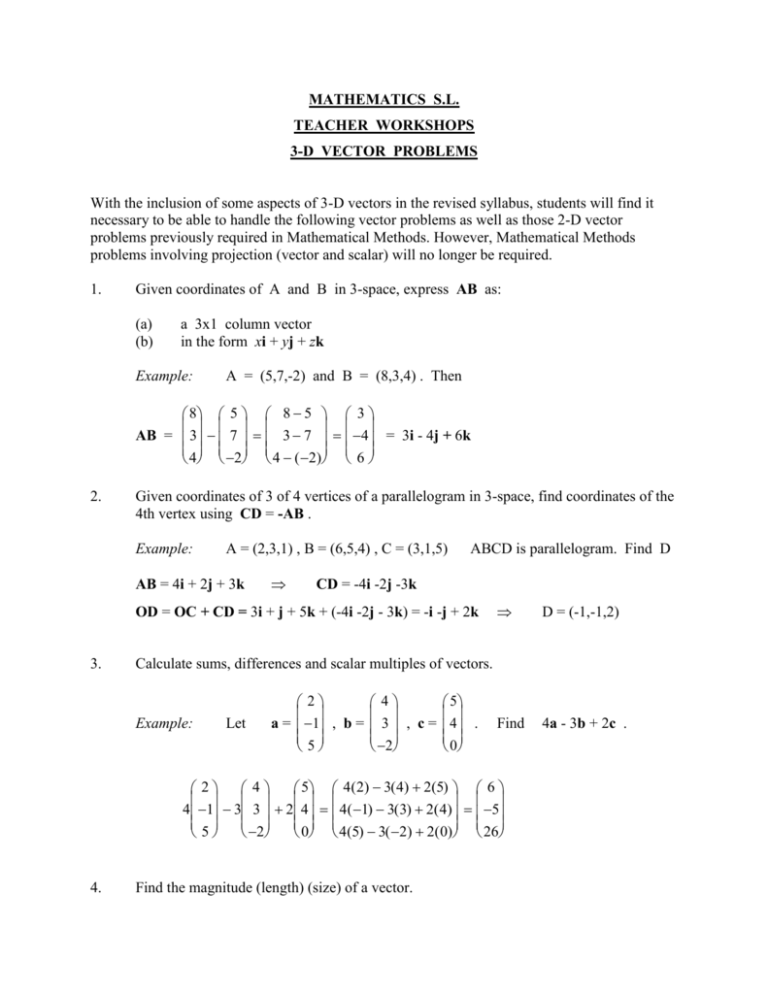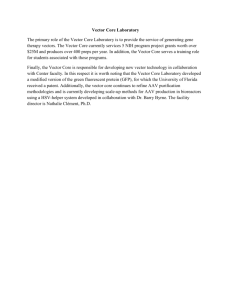Vector Examples
advertisement

MATHEMATICS S.L. TEACHER WORKSHOPS 3-D VECTOR PROBLEMS With the inclusion of some aspects of 3-D vectors in the revised syllabus, students will find it necessary to be able to handle the following vector problems as well as those 2-D vector problems previously required in Mathematical Methods. However, Mathematical Methods problems involving projection (vector and scalar) will no longer be required. 1. Given coordinates of A and B in 3-space, express AB as: (a) (b) a 3x1 column vector in the form xi + yj + zk Example: A = (5,7,-2) and B = (8,3,4) . Then 8 5 8 5 3 AB = 3 7 3 7 4 = 3i - 4j + 6k 4 2 4 ( 2) 6 2. Given coordinates of 3 of 4 vertices of a parallelogram in 3-space, find coordinates of the 4th vertex using CD = -AB . Example: A = (2,3,1) , B = (6,5,4) , C = (3,1,5) AB = 4i + 2j + 3k ABCD is parallelogram. Find D CD = -4i -2j -3k OD = OC + CD = 3i + j + 5k + (-4i -2j - 3k) = -i -j + 2k 3. D = (-1,-1,2) Find 4a - 3b + 2c . Calculate sums, differences and scalar multiples of vectors. Example: Let 2 a = 1 , b = 5 4 3 , c= 2 5 4 . 0 2 4 5 4(2) 3(4) 2(5) 6 4 1 3 3 2 4 4( 1) 3(3) 2(4) 5 5 2 0 4(5) 3( 2) 2(0) 26 4. Find the magnitude (length) (size) of a vector. Example: 5. 2 a= 6 3 Then 2 2 2 2 6 2 6 ( 3) 49 7 3 Find a unit vector (a vector of unit magnitude) in a given direction. Example: 2 Find a unit vector in the direction of the vector 6 . 3 2 2 7 1 6 6 7 From previous example, magnitude = 7 so unit vector is 7 3 3 7 6. Given a direction and a magnitude, find the vector. Example: 2 A jet is flying at 700 km h in the direction of 6 . 3 Write down its velocity vector. -1 2 7 200 v = 700 6 7 600 3 7 300 7. Express the vector (parametric) equation of a straight line given (a) the coordinates of one point on the line and a vector in the direction of the line. (b) the coordinates of two points on the line. Example: (a) Find vector equation of line through (2,1,3) in direction of 3i +5j -2k . Equation is: x 2 3 2 3 p y 1 p 5 1 5 p z 3 2 3 2 p Example: (b) Find vector equation of line through A (5,7,-2) and B (8,3,4) Vector in direction of line is AB = 3i - 4j + 6k so x 5 3 y 7 p 4 z 2 6 x 8 3 y 3 p 4 z 4 6 or Note: Students are not responsible for Cartesian equations of lines in 3-D. 8. Given the equations of two non-parallel 3-D lines in parametric form, either (a) find the coordinates of their point of intersection, or (b) show the two lines do not intersect. Example: (a) Line 1 has the equation x 5 2 y 9 s 6 z 4 3 Line 2 has the equation x 5 2 y 0 t 1 z 4 2 At their point of intersection x = 5 + 2s = -5 + 2t 2s - 2t = -10 y = 9 + 6s = 0 - t 6s + t = -9 z = -4 - 3s = -4 + 2t 3s + 2t = 0 3 equations in 2 unknowns do not usually have a solution. To check, solve 2 of the 3 equations for s and t and then find if this solution also satisfies the other equation. If it does, there is a point of intersection, if it doesn’t, there is not. In the case of our two lines, solving the equations for x and z gives s = -2 and t = 3. Checking the equations for y shows this solution satisfies all 3 equations. The point of intersection will be: x = 5 + 2(-2) = -5 + 2(3) = 1 , y = 9 + 6(-2) = 0 - 3 = -3 , z = -4 - 3(-2) = -4 + 2(3) = 2 so the point of intersection of these 2 lines is (1,-3, 2) Example: (b) Line 3 has the equation x 4 2 y 3 t 1 z 5 2 To see if line 1 and line 3 intersect, we follow the same procedure and obtain the same relation between s and t from x and z, but from y we obtain 9 + 6s = 3 - t 6s + t = -6. Since 6(-2) + 3 = - 9 - 6, we know that these lines do not intersect. Such lines are called skew lines. Note that one must use a different parameter for each of the two lines being tested. 9. Write and interpret displacement-time equations in the form: x x0 v x vx y y 0 t v y where v = v y is the velocity vector and t is time. vz z z0 v z Example: x 500 300 The equation y 200 t 400 could describe an airplane that at z 10 2 t = 0 is 500 km East, 200 km North and 10 km above the reference point and has an East velocity component of 300 km h-1, a North velocity component of 400 km h-1 and is descending towards the surface at 2 km h-1. The time in hours is given by t. 10. Calculate the scalar product of two 3-D vectors. Example: a = 2i + 6j - 3k , b = 2i - j + 2k a b = 2(2) + 6(-1) -3(2) = -8 11. Apply a b = 0 to problems involving perpendicular 3-D vectors. Example: 4 2 a = 5 , b = 1 ; 3 1 a + kb is perpendicular to b. Find k. 4 4 2k 5 5 k 4(4 2 k ) 5(5 k ) ( 3)( 3 k ) 50 10k 0 3 3 k k = -5 12. 4 5(2) 6 a + kb = 5 5(1) 0 3 5(1) 8 Use the scalar product to find the angle between: (a) two 3-D vectors in component form (b) two intersecting 3-D lines in vector (parametric) form. Example: (a) 2 a = 6 3 a 2 2 6 2 ( 3) 2 7 , 2 b = 1 2 , b 2 2 ( 1) 2 2 2 3 a b 2(2) 6( 1) ( 3)(2) 8 cos 7(3) 21 ab Example: (b) = 112.4 In exercise 8(a), Line 1 and Line 2 were shown to intersect at the point (1,-3, 2). A vector in the direction of Line 1 is vector a above. A vector in the direction of Line 2 is vector b above. Therefore, the angle between the two lines at their point of intersection is 112.4.






